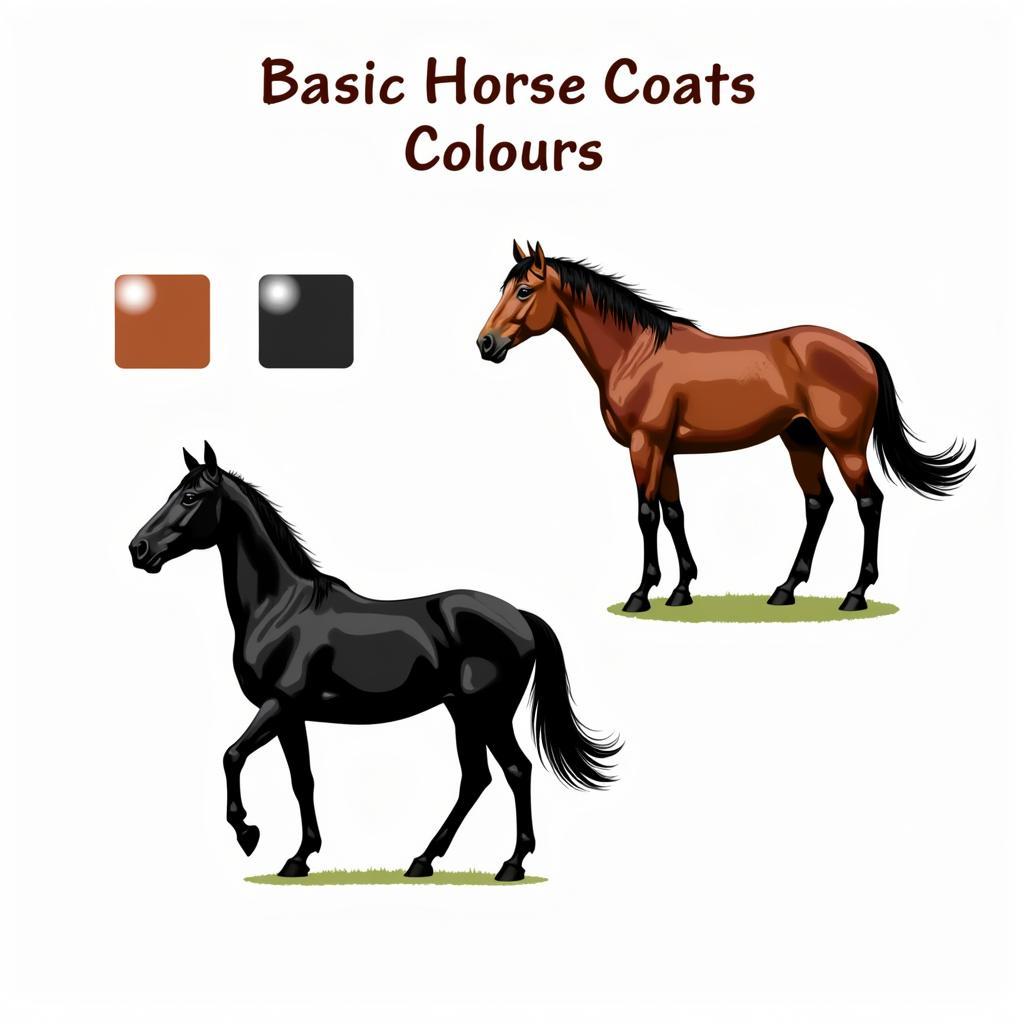Horses come in a breathtaking array of colors and patterns. From the sleek black of a Friesian to the dappled coat of an Appaloosa, the question “what color is a horse?” opens a door to a fascinating world of equine genetics and coat variations. Understanding horse colors goes beyond simple aesthetics; it can provide insight into breed characteristics, lineage, and even individual horse personalities. We’ll delve into the common and rare horse coat colors, exploring the genetics behind their beautiful hues. Want to learn more about the fastest horse color in Minecraft? Check out what color horse is the fastest in minecraft.
Understanding Basic Horse Coat Colors
Before we dive into the intricacies of horse color genetics, let’s explore the foundation of equine coat colors: black, bay, and chestnut. These base colors are influenced by specific genes and form the basis for many other variations. Black, as the name suggests, results in a horse with a completely black coat, mane, and tail. Bay horses have a brown body with black points – the mane, tail, lower legs, and sometimes the ears and muzzle. Chestnut, on the other hand, ranges from a rich reddish-brown to a lighter, almost golden shade. These three basic colors, through genetic interactions, create a vast spectrum of coat patterns. Knowing these basic colors can help you appreciate the complexity of equine coloration.
 Basic Horse Coat Colors: Black, Bay, and Chestnut
Basic Horse Coat Colors: Black, Bay, and Chestnut
Delving into Horse Color Genetics
The variety of horse colors is a result of complex genetic interactions. Two primary genes, the Extension (E) gene and the Agouti (A) gene, play a significant role. The E gene determines whether a horse will be black or red (chestnut/sorrel). The A gene modifies the black pigment, restricting it to the points of the horse, resulting in the bay color. Different alleles (variations) of these genes, combined with other modifying genes, produce the diverse array of colors we see in horses. This fascinating interplay of genes is what makes each horse unique.
How Genes Influence Horse Color Patterns
Beyond the base colors, several other genes influence patterns and markings on a horse’s coat. The gray gene, for instance, causes a horse’s coat to progressively lighten with age, often turning completely white. The cream gene dilutes the base color, creating palomino (diluted chestnut) and buckskin (diluted bay). Then there are the genes responsible for spotting patterns like those seen in Appaloosas, Pintos, and Paint horses. These intricate genetic interactions make the study of horse color a captivating field. If you’re looking to color a horse, check out a picture of a horse to color.
Exploring Rare and Unusual Horse Coat Colors
While black, bay, and chestnut are common, some horse colors are considerably rarer. Champagne, a dilute gene that creates a metallic sheen, is relatively uncommon. Silver dapple, another dilute, affects black pigment, resulting in a striking silver mane and tail on a dark body. The combination of different genes can also result in unusual colors like pearl, a rare dilution that produces a shimmering apricot or cream coat. These rare colors often make horses highly sought after. Looking for coloring pages of horses? You might be interested in para colorear caballos.
What Are the Colors of the Four Horsemen in Revelation? This question explores the symbolic colors associated with the four horsemen, adding a cultural and historical dimension to the topic of horse color. You can find more on this topic here: what are the colors of the four horsemen in revelation.
Addressing Common Questions about Horse Colors
What color is a horse foal when it’s born? Foal coats can differ significantly from their adult coloration. Gray horses, for example, are often born dark and gradually lighten.
How does a horse’s color change with age? Some colors, like gray, change dramatically over time, while others remain relatively consistent.
Can you predict a foal’s color based on its parents? Understanding horse color genetics can help predict possible foal colors, though there are always surprises.
Conclusion
The diverse world of horse colors is a testament to the fascinating interplay of genetics. From the common bay to the rare champagne, each horse coat tells a unique story. Understanding these colors allows us to appreciate the intricate beauty and individuality of these magnificent animals. So the next time you ask, “what color is a horse?” remember the complex genetic tapestry that contributes to its unique appearance. Looking for a picture of a pinto horse jumping to color? Click on a picture of a pinto horse jumping to color.
FAQ
- What is the most common horse color? Bay is typically the most common horse color.
- What is the rarest horse color? White (true white, not gray) is considered extremely rare.
- Do different horse colors have different temperaments? There is no scientific evidence linking coat color to temperament.
- What is the difference between a Pinto and a Paint horse? Both have colorful spotted coats, but Paint horses have specific breed requirements.
- What causes a horse to be gray? The gray gene causes progressive lightening of the coat.
- Can a horse’s coat color change due to environmental factors? While some factors can slightly affect coat shade, the underlying genetics remain constant.
- What are horse coat color dilutions? Dilutions are genetic modifiers that lighten the base coat color.
Common Scenarios:
-
Scenario 1: You are trying to identify a horse’s color for registration purposes. Understanding the nuances of horse color terminology is crucial for accurate identification.
-
Scenario 2: You are breeding horses and want to predict the possible coat colors of the foals. Knowledge of horse color genetics is essential for successful breeding programs.
Further Exploration:
For more information on horse colors, explore online resources and consult with equine experts.
Need Help with Your Home’s Color Palette?
Just like horses have unique coats, your home deserves a unique color scheme. Contact Color Box Hanoi at 0373298888, email us at [email protected], or visit us at 86 Cầu Giấy, Hanoi. Our team of color experts is available 24/7 to help you find the perfect palette for your dream space.

